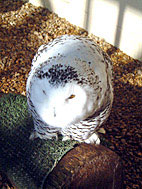

Snowy Owls are uniquely adapted to surviving in the arctic conditions of the frozen tundra. Their large appearance is comprised of thick layers of insulating feathers which allow them to brave temperatures as low as -60 degrees Celsius. Their large feet are also covered in long feathers to further protect against heat loss. Snowy Owls prey on small mammals with voles and lemmings making up the majority of the food. In fact they are so dependent upon lemmings as a food species that if lemming populations crash then Snowy Owl populations will decline and irrupt further south in search of alternative food sources. Living in the high tundra where there aren’t any trees Snowy
Owls roost and breed on the ground. To this end the sexes are coloured
differently to reflect their differing roles. Females are much more
heavily marked which provides effective camouflage when they are
on the nest, whereas males are much whiter allowing them to blend
into the snow when hunting food for the female and her brood. |
|
| Snowy Owl Facts |
| Name:
Snowy Owl - Nyctea scandiaca |

